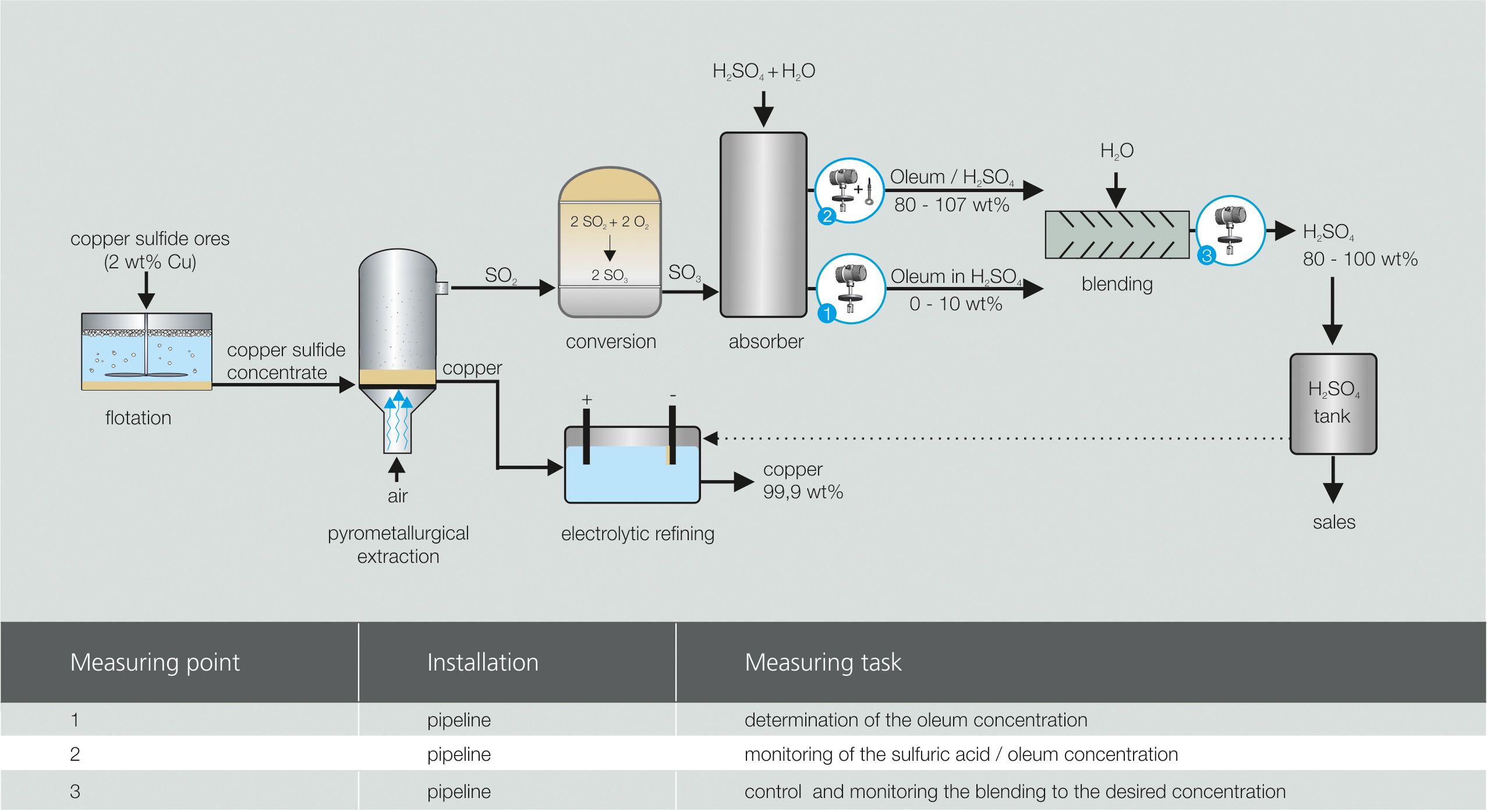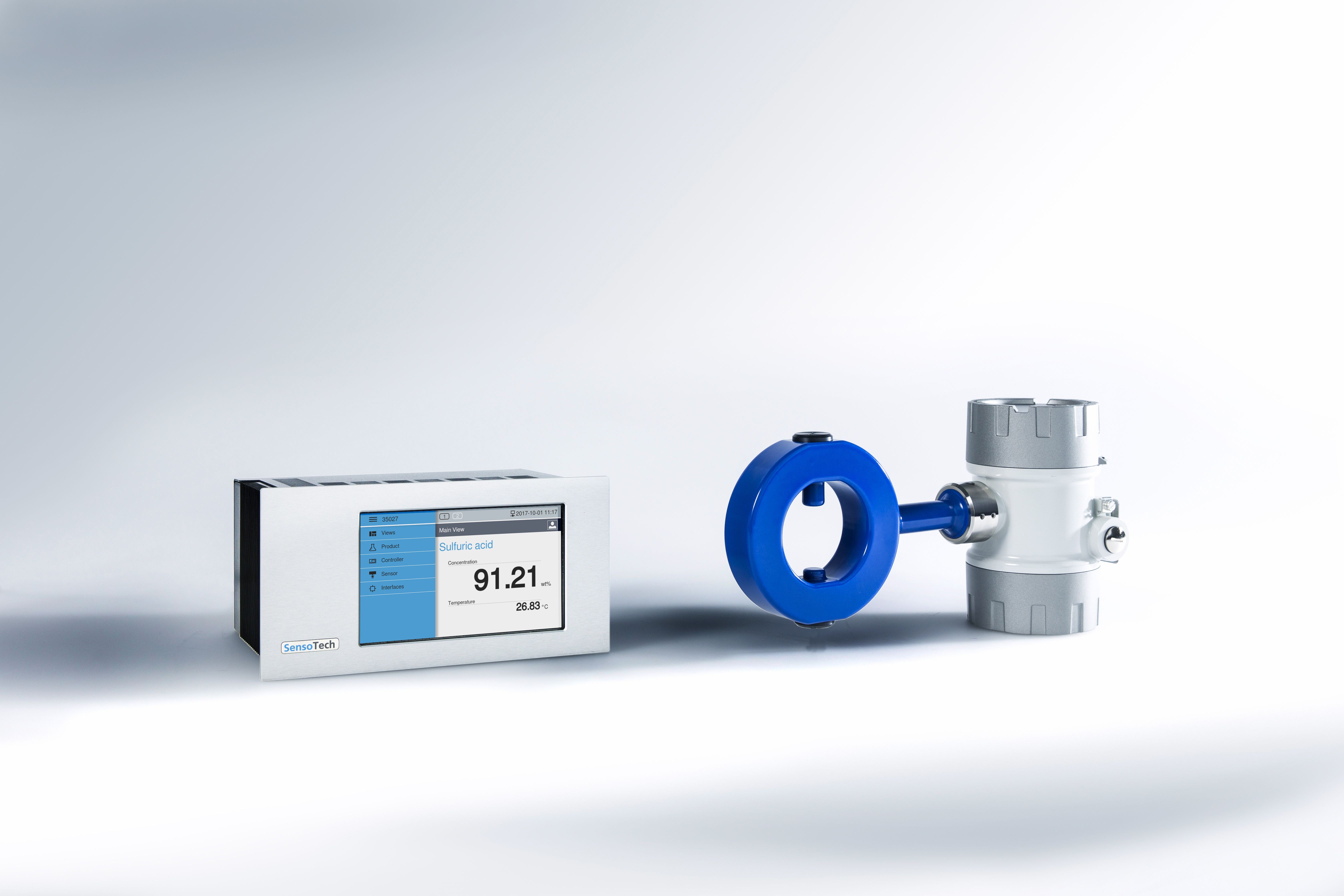Concentration and density measurement of H2SO4 in copper mining
The processing of copper sulfide ores is done by flotation. The ground copper sulfide ores are enriched with water and a frother to skim off quartz or silicates. The resulting copper concentrate has a copper content of 20-40 mass%.
In pyrometallurgical extraction, SO2 is produced, which is technically oxidized with atmospheric oxygen to sulfur trioxide (SO3) (contact process). A copper content of approximately 96 – 99 mass% remains. For a purity level of 99.99 mass%, electrolytic refining follows. This is necessary because the thermal and electrical conductivity of copper is severely affected by impurities.
Difficulty in density and concentration measurement of sulfuric acid
In the process of sulfuric acid production, process engineers often face a challenge:
Numerous measurement methods intended to measure the concentration or density of sulfuric acid function inadequately at a concentration of 85 mass% - 99 mass%. Problems arise especially when the underlying physical value of the concentration or density measuring device does not change with a change in concentration.
For example, the diagram clearly shows that conductivity sensors provide poor measurement results in a concentration range of sulfuric acid from 80 mass% - 97 mass% because the conductivity of the liquid hardly changes in this concentration range. For this reason, conductivity sensors have very low measurement accuracies when sulfuric acid is to be analyzed in this measurement range.
It is similar with density measuring devices where the density of the liquid itself is to be evaluated. It is shown that particularly in measurement ranges above 90 mass%, the density of the liquid hardly changes anymore. Therefore, many simple density measuring devices have significant problems when they are used to measure the concentration of sulfuric acid in this measurement range.
LiquiSonic® sound velocity measurement in comparison
Measure concentration and density of sulfuric acid precisely using sound velocity
Unlike conductivity sensors or density sensors, ultrasonic measuring devices are able to measure the concentration of sulfuric acid extremely precisely. With a change in the concentration of sulfuric acid, the sound velocity also changes very strongly. Therefore, concentration measuring devices whose sensors evaluate the sound velocity provide much more accurate measurement results than conductivity measuring devices or density measuring devices.
Application
In pyrometallurgical extraction, the copper concentrate is slagged with the addition of SiO2 in a reverberatory furnace at 1200 to 1400 °C. This produces a melt of copper and iron sulfide, which is separated from the slag phase as so-called copper matte. The liquid copper matte is poured into a converter and the iron sulfide is oxidized to sulfur dioxide SO with the addition of air2 oxidized. The resulting SO2 is converted to sulfur trioxide (SO3) oxidized (contact process) and the SO3 is introduced into 96% sulfuric acid in the absorber, whereby highly concentrated H2SO4 or oleum is formed. In blending, the H2SO4 is then diluted to the targeted concentration.
The individual process stages can be continuously monitored inline and optimally adjusted using Liqui-Sonic® measurement technology. Due to the high dependency of the sound velocity, an accuracy of +/- 0.05 m% is achieved with sulfuric acid.
The LiquiSonic® immersion sensors can be easily installed in the pipelines after absorption or sulfuric acid production or blending. The LiquiSonic® Controller 30 can be connected to up to 4 sensors. This makes it possible to monitor several measuring points simultaneously.
Typical measuring ranges:
Concentration range H2SO4: 80 - 100 wt%
Temperature range: 20 - 90 °C
Concentration range oleum: 0 - 30 m%
Temperature range: 10 - 60 °C
Customer benefit
LiquiSonic® ensures precise analysis and monitoring of the H2SO4 or oleum concentration with continuous data recording. The robust sensor construction and the choice of special materials, such as Hastelloy C2000, ensure long process life of the system.
LiquiSonic® reduces time-consuming laboratory measurements:
- Time savings: 1 hour per day
Compared to conductivity and density measurement, it generates LiquiSonic® a clear signal in the concentration range of 80 to 100 wt% and thus always provides reliable process information.
Copper is extracted by mining copper sulfide ores, which contain about 2% copper. The extraction of raw metal involves various process steps.





















